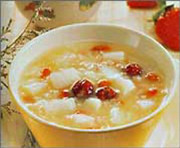| Home > Living in China > Custom |
Eating Laba Porridge on 8th Day of 12th Lunar Month
 |
The majority of Han nationality have long followed the tradition of eating laba porridge on the 8th day of the 12th lunar month, referring to the traditional start of preparation for Spring Festival. It is also a Buddhist festival on which date Sakyamuni, the first Buddha and founder of the religion, was believed to have attained enlightenment and became Buddha.
There are various Legends about the origin. One holds that over 3,000 years ago sacrificial rites called la were hosted in the 12th lunar month when people sacrificed their preys to the gods of heaven and earth. Since the ritual was held on the eighth day of the month, people later appended the number eight (ba in Chinese), giving us the current laba.
The most important activity on this day is eating Laba porridge. The story dates back to about 900 years ago. It was said when Sakyamuni was on his quest for understanding and enlightenment, he got exhausted and hungry, and fell into unconsciousness near a river in India. A shepherdess found him there and gave him her lunch -- porridge made of beans and rice. Sakyamuni was thus able to continue his journey and finally realized full enlightenment on the eighth day of the 12th lunar month.
Since then on this day sutras were chanted in the temples and rice porridge with beans, nuts and dried fruit was prepared for the Buddha. The tradition of eating Laba porridge, though based on religion, became a popular winter dish as time goes by.
Laba porridge contains glutinous rice, red beans, millet, Chinese sorghum, peas, dried lotus seeds, red beans and other ingredients, such as dried dates, chestnut meat, walnut meat, almonds, peanuts, etc. Eight main ingredients are cooked with sugar to make the porridge tasty. Laba porridge is also called babao (Eight Treasures) porridge for its high nutritional value.
The porridge is not only beneficial to health, but also is a rite of blessing that signals the beginning of Spring Festival.
Art
 more
moreDizi---A Chinese Traditional
In China,there are many varied traditional musical instruments,

Chinese Cheongsam
The cheongsam, or Qipao in Chinese, is evolved from a kind of ancient

The Dawn Breaks
(the prehistoric period - the 16th century BC) Ancient documents

Customs
 more
moreChinese Kungfu
Everybody was kungfu fighting
Niels Tsai, a kungfu enthusiast from Malaysia, was halfway up misty
Tai chi helps cut pain of knee arthritis
The traditional Chinese form of exercise known as tai chi can help
Kungfu Taste: Learn Martial Art in Shaolin Temple
The mention of Shaolin Temple conjures up images of a quiet and




 print
print  email
email  Favorite
Favorite  Transtlate
Transtlate 